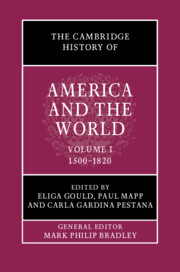Book contents
- The Cambridge History of America and the World
- The Cambridge History of America and the World
- The Cambridge History of America and the World
- Copyright page
- Contents
- Figures
- Maps
- Contributors to Volume I
- General Introduction: What is America and the World?
- Introduction: What Does America and the World “Mean” before 1825?
- Part I Geographies
- 1 Changing American Geographies
- 2 Maritime Borderlands
- 3 The Americas and the Contested Aquatic World of the Atlantic, Indian, and the Pacific Oceans
- 4 Extractive Industries and the Transformation of American Environments
- Part II People
- Part III Empires
- Part IV Circulation/Connections
- Part V Institutions
- Part VI Revolutions
- Index
2 - Maritime Borderlands
from Part I - Geographies
Published online by Cambridge University Press: 12 November 2021
- The Cambridge History of America and the World
- The Cambridge History of America and the World
- The Cambridge History of America and the World
- Copyright page
- Contents
- Figures
- Maps
- Contributors to Volume I
- General Introduction: What is America and the World?
- Introduction: What Does America and the World “Mean” before 1825?
- Part I Geographies
- 1 Changing American Geographies
- 2 Maritime Borderlands
- 3 The Americas and the Contested Aquatic World of the Atlantic, Indian, and the Pacific Oceans
- 4 Extractive Industries and the Transformation of American Environments
- Part II People
- Part III Empires
- Part IV Circulation/Connections
- Part V Institutions
- Part VI Revolutions
- Index
Summary
Indigenous Americans’ encounter with the world began at the water’s edge. Initial encounters with Europeans happened on beaches, on islands, and on the water itself. As foreign powers began to colonize the Americas, saltwater fringes would form some of the most profitable and contested regions. This fact, which scholars have only recently started to examine with care, goes against common assumptions about where “borderlands” and “frontiers” are supposed to take shape. Looking to the continent’s margins reveals a distinct category of contested spaces that did not work by the same rules as terrestrial ones. From the fifteenth to the eighteenth century, two particular American coastal regions faced economic, political, and cultural changes that were all connected to the underlying ecological dynamism of shorelines.
- Type
- Chapter
- Information
- The Cambridge History of America and the World , pp. 60 - 79Publisher: Cambridge University PressPrint publication year: 2022



